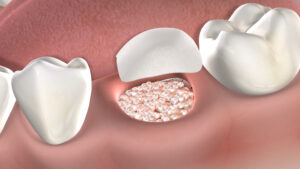 If you have been missing teeth for a while, the jaw bone may have weakened, making it difficult to place dental implants. With bone grafting, we can rebuild the jaw bone to create a solid foundation for implants. By using the latest bone grafting techniques, our board-certified oral surgeons can help more patients become candidates for implant-based tooth restorations.
If you have been missing teeth for a while, the jaw bone may have weakened, making it difficult to place dental implants. With bone grafting, we can rebuild the jaw bone to create a solid foundation for implants. By using the latest bone grafting techniques, our board-certified oral surgeons can help more patients become candidates for implant-based tooth restorations.
Bone grafting is often a part of dental implant treatment, as a sturdier foundation leads to better results. During your consultation with Dr. Salin, Dr. Weiner, Dr. Semanoff, Dr. Nack, and Dr. Kosakowski we’ll design your custom treatment plan to see if bone grafting is right for your needs. Contact Innovative Oral Surgery & Dental Implants today in Feasterville-Trevose, Newtown, or Abington, PA, to see how bone grafting can improve your oral health or help you qualify for dental implants.
In addition to helping you eat and speak, teeth play an important role in keeping your facial bones and soft tissues strong. This is because teeth roots stimulate the jaw bone, keeping it healthy. When teeth are missing, the jaw bone does not receive stimulation and deteriorates. Over time, this can lead to facial imbalance or cause facial features to sag.
Bone grafting works by stimulating more bone to grow in a specific area. Your surgeon will place a grafting material in the face or jaw bone and your body will naturally heal around the graft, resulting in stronger bone.
Rebuilding facial bone is often a part of dental implant treatment. Bone grafts also help patients who have experienced facial trauma or birth defects rebuild bone and tissue, improving facial symmetry, and strengthening the oral and maxillofacial regions.
At Innovative Oral Surgery & Dental Implants, we offer many types of grafting procedures to reverse bone loss or soft tissue deterioration. During your first visit, we will take 3D scans of your mouth and face to determine if bone grafting is necessary and which treatment is right for you.
Your sinuses are empty spaces behind your cheeks above your upper teeth. Sometimes, the roots of upper teeth develop near the floor of the sinuses. If these teeth fall out, the sinus floor will begin to deteriorate. With a sinus lift, we place graft material into the sinus to reinforce this wall and create a strong foundation for future implants.
A ridge expansion is necessary when the jaw is not wide enough to support dental implants. We will divide the jaw bone and insert bone graft material into the open space. Once the graft heals, the jaw will be larger and able to support dental implants.
Healthy gums are essential for supporting dental implants and maintaining good oral health. With soft tissue grafts, we can treat gum recession to better support the teeth and achieve a more symmetrical appearance.
Cases that require bone in larger areas, such as facial trauma cases or due to skeletal defects, may require a major bone grafting procedure. For this type of graft, your surgeon will harvest bone from the hip, tibia, cranium, or elsewhere in the body and place it where new bone is needed.
Our surgeons at Innovative Oral Surgery & Dental Implants offer many contact options for your comfort. We will help you select the right choice for the type of bone grafting procedure and your level of anxiety. Bone grafting is typically performed using local anesthesia and IV anesthesia. For major bone grafting, we will use general anesthesia.
At your surgical appointment, your oral surgeon will make an incision in the mouth to access the area where more bone or tissue is needed. We will insert the grafting material and place sutures to close the surgical site.
The recovery time after bone graft surgery is fairly quick, and most patients resume their normal activities within a day or two. You will receive post-operative instructions to help you care for your surgical site and manage any discomfort during recovery.
When placing a bone graft in preparation for a dental implant, the bone graft will take anywhere between 4 and 6 months to heal. You will be ready to undergo dental implant surgery once the bone graft has fully healed.
With bone grafting, our oral surgery experts can manage more cases of bone or soft tissue deterioration and help more patients receive long-lasting dental implants. Schedule your consultation with one of our board-certified oral surgeons today by contacting Innovative Oral Surgery & Dental Implants in Feasterville-Trevose, Newtown, and Abington, PA, to find out how bone grafting can rebuild your smile and restore your oral health.
We offer a variety of choices to ensure a comfortable oral surgery experience.
For over 50 years, we have had the privilege of serving our communities with the highest level of oral surgery care. We love what we do, and we look forward to providing you and your loved ones with an outstanding patient experience and incredible results.
Administered through a syringe, a local anesthetic numbs only the surgical site. The effects can last up to several hours. We often pair local anesthesia with another type of anesthesia or sedation.
Commonly known as laughing gas, nitrous oxide is inhaled through a mask. It provides mild sedation and pain relief and is often combined with other options, such as oral sedation, for optimal effect.
General anesthesia will render you totally unconscious. This option is reserved for complex surgeries such as orthognathic surgery or facial reconstruction.
Your surgeon will inject the sedative into the vein, which will render you into a semi-conscious state. Also called twilight sedation or twilight dentistry, this option is ideal for extensive procedures or highly anxious patients.